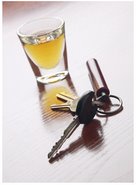Physiological Responses To Ethanol
Blood Alcohol Category of Dose Response Relationship for
Concentration Influence the Non-Habituated Consumer
0.01%-0.04 SUBACUT Social/Emotional: No behavioral changes
apparent to the casual observer. Influence negligible.
Cognitive: Shared Attention deficits detectable in sensitive individuals.
Memory: Unaffected
Fine Motor Abilities: Slight changes detectable by specialized tests.
Balance: Normal
Depressant Effect: Very Slight
Vision: Normal
0.03%-.12 EUPHORIA Social/Emotional: Mild state of euphoria;
increase in self-confidence and a decline in inhibitions; increase in sociability and gregariousness; decline in judgment and ability to comply with social controls.
Cognitive: Decline in information processing ability. Decreased attention.
Memory: Long-term memory basically unaffected. Short-term memory deficits apparent at 0.07% and above.
Orientation: Slightly narrowed.
Fine Motor Abilities: Sensory motor impairment begins. Information processing slowed resulting in a decline in performance on specialized tests
Balance: Baseline coordination deficits apparent on certain balance and coordination tasks.
Depressant Effect: Slight
Vision: Pursuit tracking significantly affected above 0.06%. Pendular nystagmus consistently present above 0.05%.
0.09%-.20 INTOXICATED Social/Emotional: Emotional
instability with a loss of critical judgment. Behavior manifested that is uncharacteristic of the subject in the sober state.
Cognitive: Impairment of perception and comprehension.
Memory: Declines evidence in both long and short term abilities.
Orientation: Loss of social awareness
Fine Motor Abilities: Gross deterioration.
Balance: Coordination grossly affected and inability to maintain balance evidence. Sensory motor incoordination.
Depressant Effect: Drowsiness
Vision: Reduced visual acuity with decrease in peripheral vision and glare recovery. Flicker fusion consistently appears.
0.18% - 0.30% CONFUSION Social/Emotional: Mental confusion.
Exaggerated emotional statres (fear, rage, sorrow).
Cognitive: Inncoherence
Memory: Continuing decline in ability to recollect past and present events.
Orientation: Disorientation
Fine Motor Abilities: Only slightly functional
Balance: staggering gait, increasing muscular incoordination with corresponding increased pain threshold.
Depressant Effect: Apathy and lethargy.
Vision: Diplopia (double vision). Disturbances of perception, color, form, motion & dimensions.
0.25% to 0.40% STUPOR Social/Emotional: Complete loss of social
awareness. General inertia.
Cognitive: Marked decreased response to stimuli.
Memory: Unreliable.
Orientation: Non-existent
Fine Motor Abilities: Lost
Balance: Inability to stand and marked muscular in coordination.
Depressant Effect: Impaired consciousness, sleep.
Vision: Only slightly functional and very blurred.
0.35% - 0.50% COMA Social/Emotional: Unconsciousness.
Cognitive: Coma
Orientation: Life threatening state. Abolished reflexes with incontinence of urine and feces.
Fine Motor Abilities: Anesthesia state with depressed or abolished reflexes.
Depressant Effect: Anesthesia state. Impairment of circulation and respiration. Subnormal temperature. Death possible.
Vision: Non-functional.
0.45 + DEATH Death from respiratory arrest can occur.
Dubowski, Kurt M. “Stages of Acute Alcohol Influence/Intoxication,” University of Oklahoma College of Medicine, 1985; Giguire, Williams E., “The Quantitative Measurement of Driving Impairment in the Field, “ Tenth International Conference of Alcohol, Drugs and Traffic Safety, Amsterdam, The Netherlands, 1986.
Subscribe to:
Post Comments (Atom)


No comments:
Post a Comment